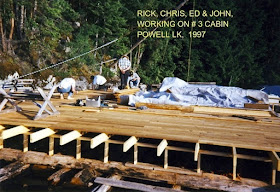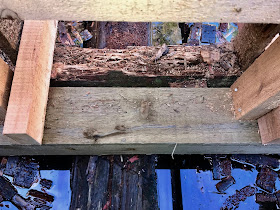 |
| Spring 2018 before pressure washing. |
Just like any home, it's only as good as the foundation.
 |
| After removing the stain aging was evident. |
Periodically, we've replaced individual boards and a few supports to extend the life of our foundation and deck, but in 2019 it was evident that we needed to do much more.
 |
| Our float cabin's raft during construction. |
Crosswise logs and steel cables secure the float logs together. On top, pony walls of vertical then horizontal 2x4s are nailed into the cross-member logs. This provides a level platform for the cabin and deck.
 |
| The pony walls are then added to the float log foundation. |
Vertical 2X6" boards are nailed on top of the pony walls. Throughout this process, everything is double-checked to make sure it's level.
 |
| To support the deck boards, vertical 2x6s are nailed on top of the pony walls. |
Yellow cedar is best for decking. Next is old growth red cedar. Last is second growth cedar. Most of our foundation was yellow cedar, but a few spots included second growth wood.
 |
| A second growth cedar log on top was replaced with an old growth cedar beam. |
Our good friend John (and cabin's builder) replaced our deck. When he took off the old boards, he discovered several supports that needed replacing. In particular, a second growth log was rotten. He chose to replace all 40-feet with milled 6X6" beams.
Here are some related cabin construction posts:
Float construction
Extra Flotation Power
Pumped
Log Burning for Dry Rot
Cable Up - Anchoring System
In Part 2 I'll tell more about the deck replacement process. -- Margy









